05 – 28 APRIL 2023
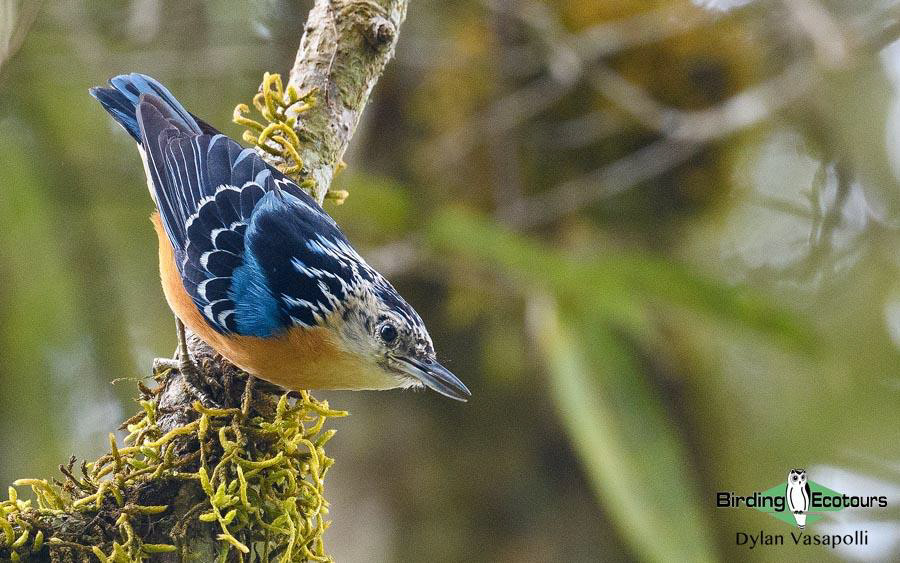
Beautiful Nuthatch is one of the many sought-after specials we found on our Bhutan tour.
Overview
Fabled Bhutan is an isolated country in the Himalayas nestled between India and China. With tourist access strictly controlled and regulated, the country was for all intents and purposes firmly out of bounds to tourists for much of the Covid pandemic period from March 2020 until late 2022.
This tour was initially scheduled to take place during April of 2020, but had to be postponed for several years, and was finally allowed to run during April of 2023, once Bhutan’s borders had opened. This Bhutan set departure birding tour was run solely for a couple, Ron and Ruth, with a few days added on at the start for more cultural-orientated activities. Almost immediately before the tour began, we were dealt with another blow as the land border between Bhutan and India, at Samdrup Jonkhar, was closed. This meant that we could no longer end our tour in Guwahati, India, as intended, and therefore needed to add an extra day to the tour, allowing us to catch a domestic flight from Trashigang back to Paro, where the tour would now end.
This long tour, spanning 24 days took in a long route from Paro in the west of the country, to the Tingtibi lowlands in the central-southern reaches, and all the way to Trashigang in the far east of Bhutan – before returning back to Paro. In addition, the auspicious hike up to the world-famous Tiger’s Nest Monastery, or Taktsang, was a thrilling experience. Travel in the country is generally slow, due to the mixture of superb birding habitat found on the side of major roads (which necessitates time to slowly bird and explore these areas), and the very windy nature of these mountain roads.
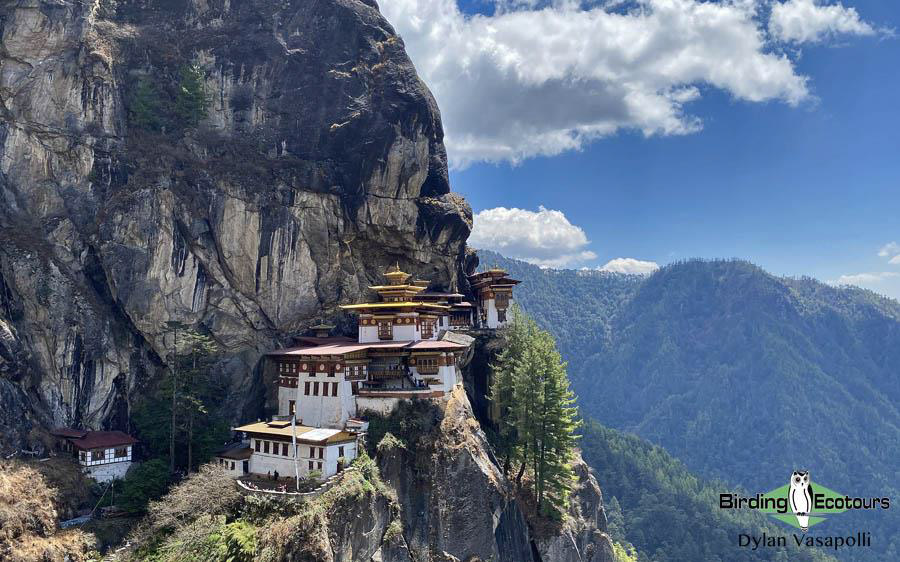
Bhutan is a scenically unbeatable country! Incredible vistas await around almost every bend, and arguably none compare to the incredible Tiger’s Nest Monastery, shown here – perched high up on a rocky ledge.
Despite three years of isolation, and a lack of birding generally around the country during that period, the tour went along reasonably well, with only a few bumps along the way. Birding was excellent, and we netted virtually all of Bhutan’s major birding targets – from the mega Satyr Tragopan and beautiful Himalayan Monal, to denizens like Ibisbill, Fire-tailed Myzornis, Beautiful Nuthatch, Ward’s Trogon and the very rare White-bellied Heron. All in all, over 300 species of birds were seen on this tour. Mammals are decidedly less numerous in Bhutan, and we did well to find a Yellow-throated Marten, along with the stunning Gee’s Golden Langur and enormous Black Giant Squirrel.
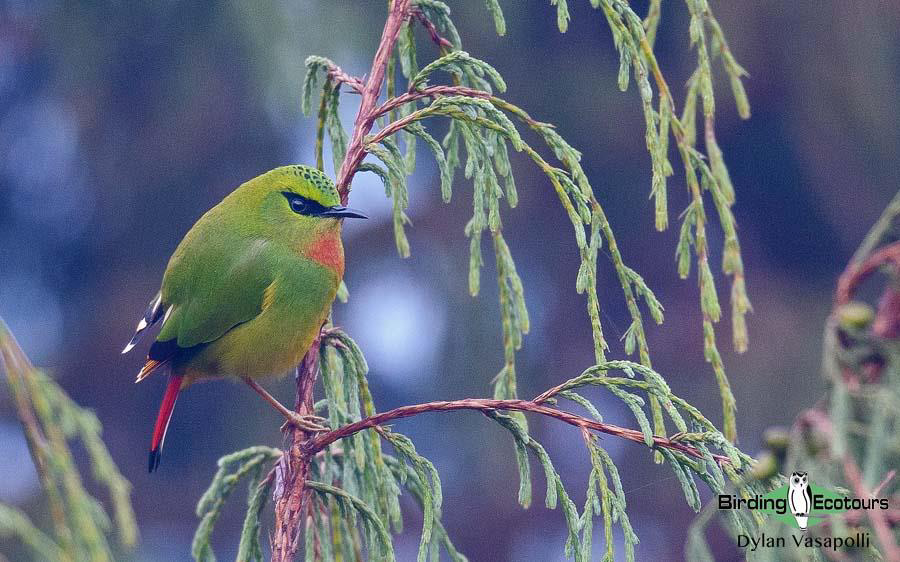
Fire-tailed Myzornis is an uncommon and scarce bird in the country. We did well with several excellent sightings on this tour.
A detailed daily account can be read below, and the full bird and mammal lists are located at the end of the report.
Detailed Report
Day 1, 05th April 2023. Arrival in Paro – Paro Festival and local birding
Following an early arrival into the spectacular Paro airport, we checked into our comfortable hotel for a short rest. Mid-morning came, and saw us heading to the massive Rinpung (Paro) Dzong, where we would enjoy the Paro festival for a while. In between all the dances and stories commemorating this festival, the many Red-billed Choughs that breed in the Dzong kept us company, and some of the quieter sections of the festival held the likes of Chestnut Thrush and Grey-backed Shrike. The Paro Chu (River) also gave us our first River Lapwing, Brown Dipper and Plumbeous Water Redstart. A break over the midday period followed, before we resumed with a more dedicated birding session – as we explored the Paro surrounds. Focusing on the upper reaches of the Paro Chhu (River), we did extremely well to find the scarce Solitary Snipe quietly feeding amongst the rocks, while Green Sandpiper, River Lapwing, White-capped Redstart and Rosy Pipit kept it company. A nearby marshy area delivered a stunning pair of Black-tailed Crakes that put on an excellent show, while the surrounding scrub gave up both Black-throated and Red-throated Thrushes, Hodgson’s Redstart, Russet Sparrow and large numbers of Little Buntings. Content and tired, we settled in for the evening.
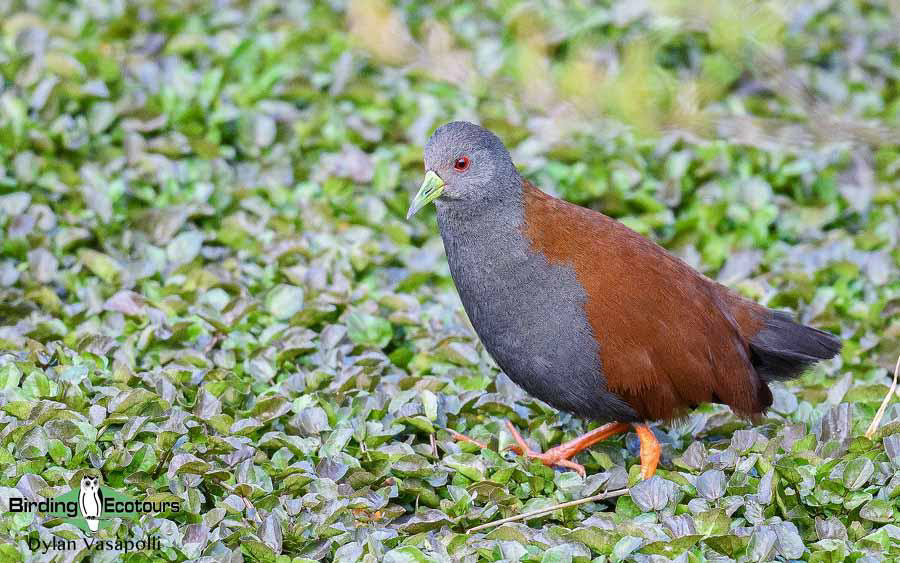
A Black-tailed Crake pops out from the dense cover for a short moment.
Day 2, 06th April 2023. Birding Chele La Pass
The first of many early starts on this tour saw us tackling the winding road heading up to the famous Chele La Pass, outside of Paro. This pass winds up to almost 4000m at the top, and we slowly worked our way up, stopping off at various altitudes to look for different birds. The many different pheasants that can be seen on the pass are arguably the biggest attraction, and would indeed be our main focus. Kalij Pheasant showed extremely well on the lower slopes of the pass, with several pairs feeding quietly on the edge of the road. Satyr Tragopan also occurs along the middle elevations, but was conspicuous only by its absence. Blood Pheasants followed, and were dime a dozen in the upper reaches of the pass, with many birds showing well. Near the top is the realm of the Himalayan Monal, and during our (much-needed) coffee break high up, we heard the distinct call of this beautiful pheasant, and rushed off to try and find it, leaving our coffee behind. As if right on cue, we had a stunning male in the scope feeding in an open gap in the woods, before it climbed a small stump to call once again. We soaked up our amazing views of this incredible bird, before leaving it in peace, and returning back to our cold coffees. Comical Yellow-billed Blue-Magpies roved about at our breakfast stop, while noisy Spotted Nutcrackers called from the tops of the pines. The very top of the pass still had a bit of snow, and here we enjoyed our first laughingthrush – Black-faced Laughtingthrush, as they bounced around. Careful scrutiny of the small shrubs here gave us busy White-browed Fulvettas and a large party of Rufous-vented Yuhinas, while stately Blue-fronted Redstarts were commonly seen. A large flock of Plain Mountain Finches was the last sighting of note, before we started working our way back down to Paro for a midday break. The afternoon was leisurely spent birding around the Paro Chhu (River) slightly further afield from town, and here, we did well to find a pair of the highly sought-after Ibisbills. We spent some time watching these masterfully camouflaged birds (they almost perfectly resemble the rocks they feed within) go about their business, before setting off to try for another highly desired bird, Wallcreeper. We were unsuccessful in our quest for Wallcreeper, but did find the likes of Eurasian Hoopoe, Eurasian Kestrel, Black Bulbul and the beautiful Rufous-breasted Accentor.
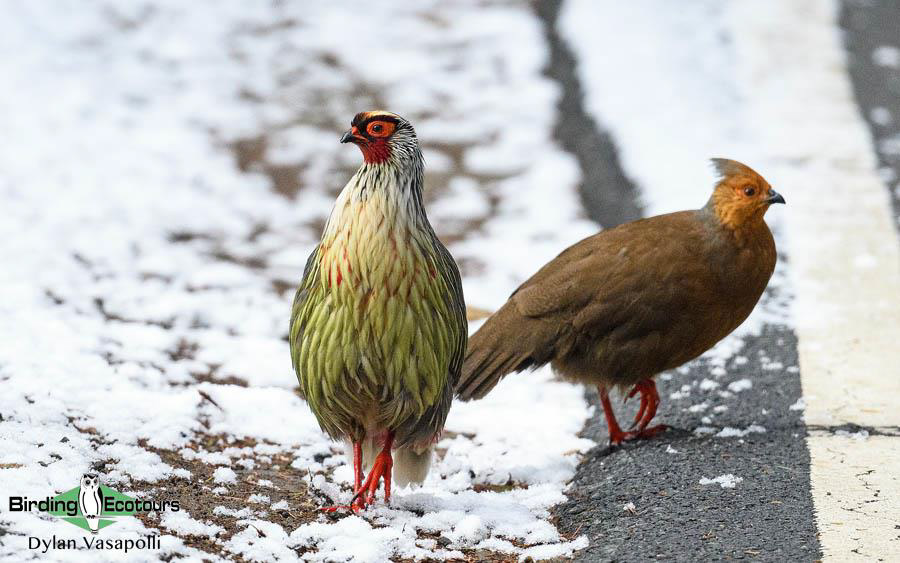
Blood Pheasants feeding in the road were an early tour highlight.
Day 3, 07th April 2023. Hike to Tiger’s Nest Monastery
Arguably Bhutan’s biggest tourist attraction is the famous Tigers Nest Monastery, or Taktsang – where many tourists undertake the arduous and steep hike to visit this famous monastery, which is rich in Buddhism. We had the day dedicated to undertaking this hike, and set off in the morning, slowly making our way up the steep trail to get to the monastery. We soaked up this incredible area, making our way back down in the afternoon. Birds are sparse along the way, due to the high volumes of people that walk this path every day, and today was no different with birds thin on the ground. The denser areas lower down held a delightful family of Streak-breasted Scimitar Babblers along with Rufous Sibia, which would become one of our regulars on the tour. The pine woods higher up produced numbers of Green-backed Tits, along with a party of Grey-crested Tits. Blyth’s Leaf Warblers were extremely common and a small bird party right near the actual monastery delivered the stunning Mrs. Gould’s Sunbirds and our first minivet – Long-tailed Minivet. A large flock of Blyth’s Swifts wheeled about above the monastery, while we picked up our first Alpine Accentor on the monastery itself. Once back down from the hike, we stopped off to see our Ibisbills again, and tried once more for the Wallcreeper, which eluded us yet again, before calling it a day.
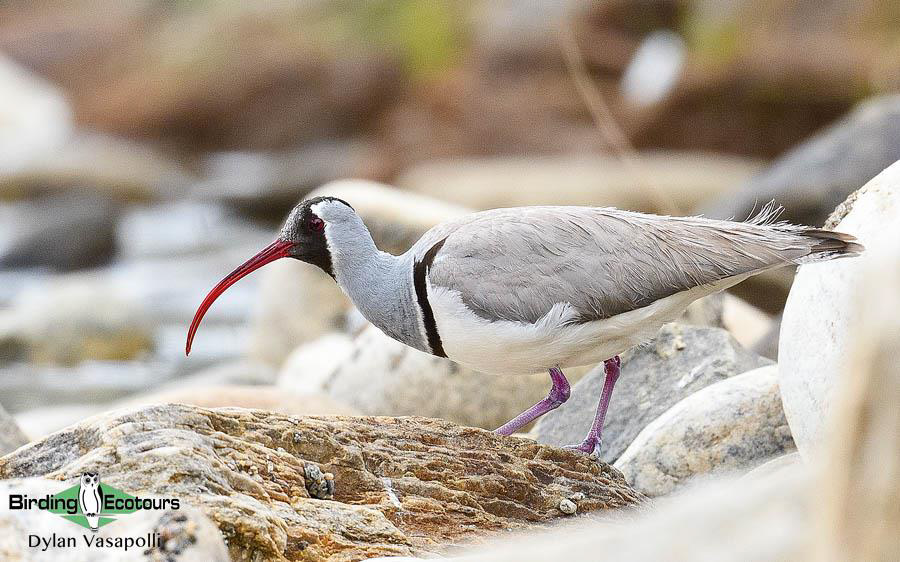
We enjoyed spending time with the sought-after Ibisbills around Paro – surely the best place in the world to see this species!
Day 4, 08th April 2023. Birding Chele La Pass to Haa
We left our lovely Paro hotel, bound for the culturally-focused Haa valley – the route, however, takes us up and over the Chele La Pass, and we would spend the full morning birding along the pass once again. We did well on Day 2 earlier in the trip, notching up most of the pheasants, and we would focus more of our time on those we missed, like Satyr Tragopan. The mid-elevation pine woods were birdy, and parties of birds kept us entertained. Buff-barred Warblers and Coal Tits dominated, and were occasionally joined by the likes of Long-tailed Minivet, Grey-crested Tit, White-browed Fulvetta, Rufous-vented Yuhina and Goldcrest. We then heard the eerie call of a Satyr Tragopan, unfortunately though, it was deep into the forest and our attempts at finding it were unsuccessful. We refocused and ventured up to the Kila Goenpa Nunnery, set on a rocky ledge above the forest. We had some superb birding here with flocks of Altai Accentors feeding on the ground and parties of boisterous Black-faced Laughingthrushes flitting about. Some careful scanning between the laughingthrushes gave us our first Spotted Laughingthrush – a truly massive bird in comparison! Arguably the main drawcard here was the large flock of Snow Pigeons that frequent the buildings. We spent some time watching these dapper-looking birds and marveled at their beauty. Several other species we were now familiar with were seen as well. We passed over the top of Chele La Pass, taking in the spectacular views and seeing the surrounding peaks, all covered in snow from a late fall. Birding was slow up here, as it was approaching midday, and we pressed onwards down the other side of the pass into Haa. A circling Himalayan Buzzard was the only notable sighting. Following a short rest, we set out to explore the town of Haa, taking a walk along the river. A superb Ibisbill showed well early doors, as did several Brown Dippers and the expected Plumbeous Water and White-capped Redstarts. Little else was seen, though we enjoyed exploring the quaint town.
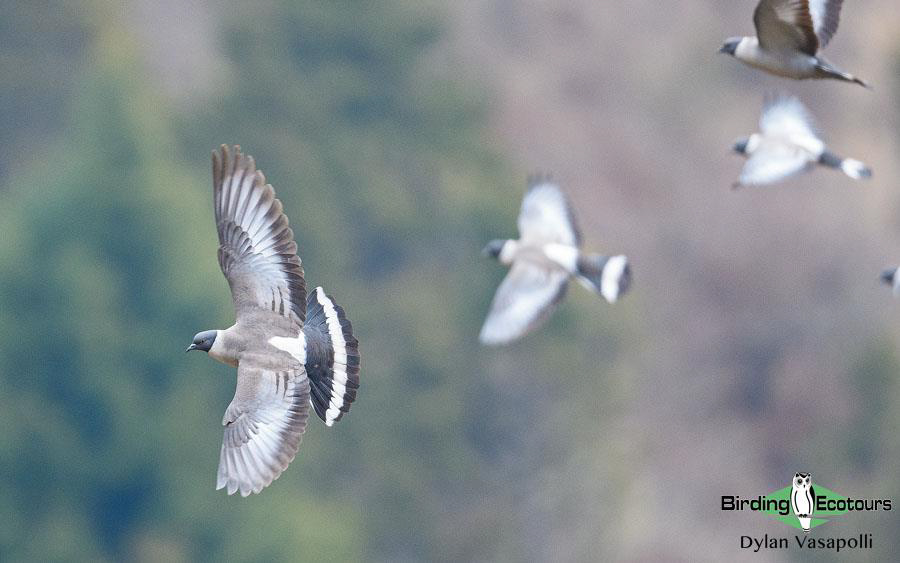
Beautiful Snow Pigeons put on a fine show for us.
Day 5, 09th April 2023. Back to Paro
Having enjoyed our time in the Haa valley, today would see us head back up and over the Chele La Pass for the final time, and back into Paro, where we would spend the night. We made sure we were at the top of the pass for the best morning birding, and enjoyed a wealth of activity. Several Blyth’s Swifts were floating overhead, before a Common Kestrel replaced them, followed by a lovely Himalayan Buzzard. Several bird parties were present in the woods, and new birds included Hodgson’s Treecreeper and White-winged Grosbeak. We also enjoyed other familiar species like Grey-crested Tit, Long-tailed Minivet, White-browed Fulvetta and Black-faced Laughingthrush. The rocky ledges at the very top finally delivered some Alpine Accentors. Flowers were starting to come out in the open areas, and this seemed to attract both Rosy and Olive-backed Pipits, with numerous birds feeding in the open fields. After having only managed glimpses before, we finally enjoyed excellent views of a bright male Himalayan Bluetail. Many Large-eared Pikas were dancing around as well. As we slowly made our way back towards Paro, birding stops along the way yielded a showy Green Shirke-babbler and several Ashy Drongos. Near the bottom, we lucked onto a stunning Yellow-throated Marten crossing the road. We checked back into our familiar hotel, and after a short rest, headed off to see if we could find ‘our’ Ibisbills. We were glad to see they hadn’t gone anywhere, and also got to watch them courting one another, which eventually resulted in mating. All the rest of our usuals were seen as well, with delightful River Lapwings, stately Grey-backed Shrikes, bright Chestnut Thrushes and bold Russet Sparrows.
Day 6, 10thApril 2023. Birding Thimpu and Jigme Dorji National Park
We were up and out of Paro nice and early, bound for the country’s capital city, Thimpu. We headed straight for the local sewage works where we added a head of new birds. Several Gadwall were sitting on some of the ponds, and were soon joined by a lone Common Pochard, while several Ruddy Shelduck and a Eurasian Coot frequented another pond. Numbers of both Common and Green Sandpipers were present. The surrounds gave us several stunning Black-throated Thrushes along with a lone White-browed Wagtail feeding amongst the hordes of White Wagtails. We then set off for the Cheri Valley and the lower sections of Jigme Dorji National Park. Our first stop was at a known stakeout for the rare Yellow-rumped Honeyguide, which after a little wait, obliged and gave us some good scope views.
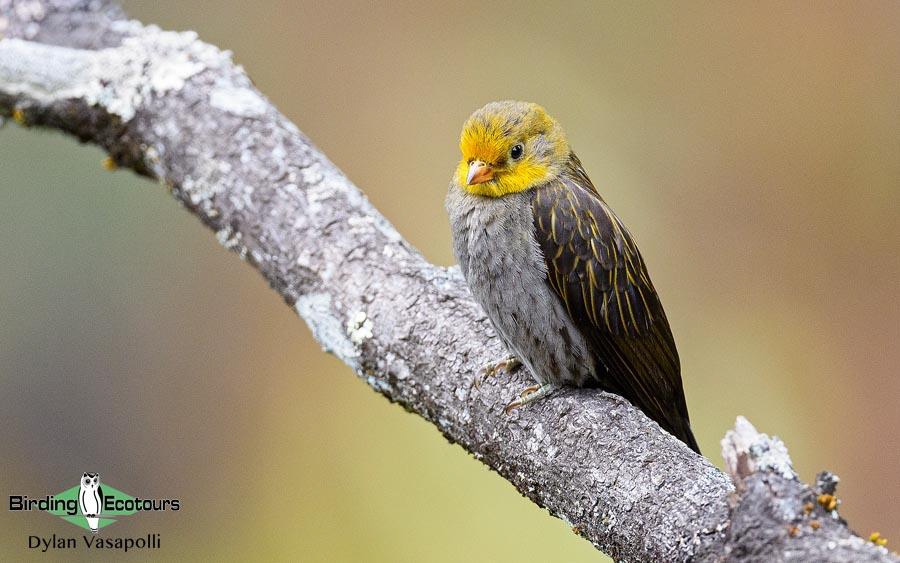
Yellow-rumped Honeyguide are often seen around colonies of rock bees.
With the change to more broad-leafed forests, away from the coniferous forests we had spent virtually all our time until now, we had another heap of new trip birds come pouring in. A pair of Grey-headed Canary-flycatchers flitted into view, and were chased away by a territorial Rufous-gorgeted Flycatcher. A small flowering tree gave us both Mrs. Gould’s and Green-tailed Sunbirds, and the somewhat drab Yellow-browed Tit. An Alpine Thrush flushed up off the ground and settled high in the trees, and a curious White-tailed Nuthatch came to investigate. Bright Chestnut-crowned Warblers and Rufous-bellied Niltavas were crowd favorites and a group of noisy Whiskered Yuhinas left us wanting a bit more. The very different-looking Moupin Pika was seen as well. After lunch back in Thimpu, we explored the town for a little bit, before taking a visit to the Takin sanctuary on the outskirts of town. Takin is a strange, large goat-like mammal occurring in this part of the Himalayas, and we marveled at these unique animals, though in captivity. As always, there were lots of birds around, and we managed to add a group of shy Chestnut-crowned Laughingthrushes to our tally, along with enjoying other familiar birds like Long-tailed Minivet, Rufous Sibia and White-throated Laughingthrush.
Day 7, 11th April 2023. Birding Dochula Pass to Punakha
Another early start saw us heading up to the Dochula Pass, and our first bird went to a lovely Kalij Pheasant walking in the road. We started off our birding right at the top, around the temple, just as the sun was rising. Despite us nearly freezing, the birds were up and about, and we started off with a bang, finding one of our targets, Great Parrotbill, within seconds. This is an enormous bird – easily triple the size of most other parrotbills, and it put on quite the incredible show for us, showing at arm’s length. We were then whisked off to search for Fire-tailed Myzornis. We heard them easily, and after a struggle managed our first views of this sought-after bird, though our views did leave a bit to be desired. We stuck it out for a while longer, and were aptly rewarded with stunning looks at a large flock of them. We also picked up our first Stripe-throated Yuhina. We retreated for a warm cup of coffee and breakfast at the restaurant.
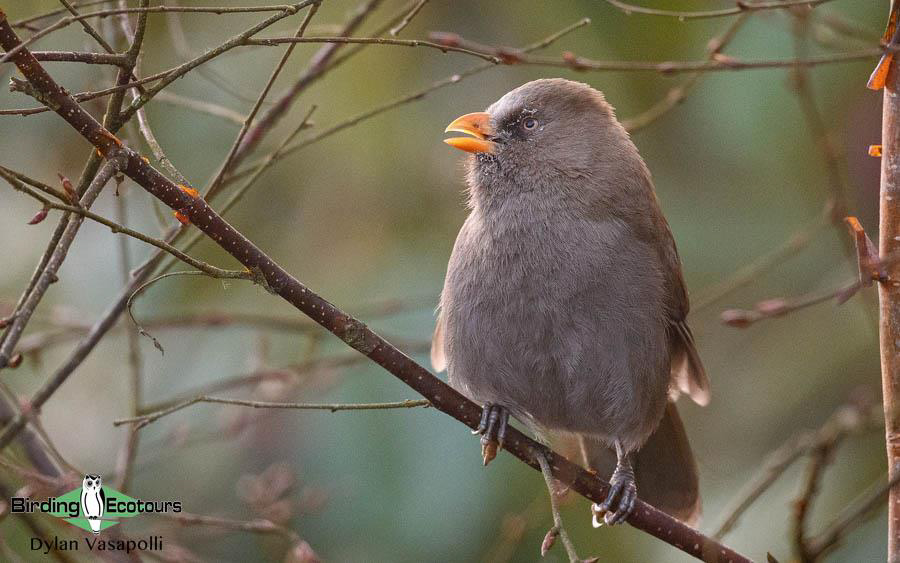
The massive Great Parrotbill was a superb bird to start the day off with.
After having thawed out, we focused our search on Ward’s Trogon. Try as we might, we were unable to find any trogons, but enjoyed numerous other birds as we went about our business. Himalayan Cuckoo played hide and seek with us, but we managed to pry one out without too much difficulty. Our first warbler flock netted us Whistler’s, Lemon-rumped and Grey-hooded Warblers, and also found feeding with them were several Rufous-capped Babblers. Hulking Striated Laughingthrushes showed well, as did both the snazzy Black-faced Warbler and the shy Brown-flanked Bush Warbler. Grey-bellied Tesia refused to show, however, with the bird moving through the vegetation unseen on the edge of the road.
We also spent a bit of time birding the Royal Botanical Park, where we successfully tracked down one of the many calling Large Hawk-Cuckoos. Great Barbets showed well perching in the open, as did a pair of fine Rufous-bellied Woodpeckers. Warbler flocks here contained the same species, along with Ashy-throated and Tickell’s Leaf Warblers, and a busy party of Rufous-winged Fulvettas showed well. A vocal Grey-sided Laughingthrush, a scarce species, left us wanting a bit more. An attempt to see a calling Hill Partridge was completely unsuccessful, however. A stunning Black Eagle also graced us with a flyby.
We broke for lunch in between all the birding, and our afternoon saw us head down the pass into the Punakha valley. A birding stop along the way added a lovely Blue-capped Rock Thrush. In the Punakha valley, a fierce wind was blowing, and we opted to rather head to our hotel and venture out for some late afternoon birding, once the wind had hopefully died down. Unfortunately, this didn’t happen and we braved the wind for a little bit. We found a nice gathering of waterfowl in the river, which included many species – Common and Ruddy Shelducks, Northern Shoveler, Gadwall, Eurasian Wigeon, Northern Pintail, Tufted Duck and Red-crested Pochard were all frolicking about together. Nearby, a Common Merganser was also bobbing away. A stunning Pallas’s Fish Eagle flew over the river, giving us all good views. Tired of the wind, and with sand everywhere, we called it a day and settled in the for the evening.
Day 8, 12th April 2023. White-bellied Heron at Punakha
The main birding target of the Punakha valley is White-bellied Heron. This Critically Endangered bird is, unfortunately, in a very bad way, and fewer than 250 birds are thought to be left in the wild. A few birds roam up and down the river in the Punakha valley, and this is usually the most reliable spot in the country to see this mega bird. Several other birding groups were working the area as well, and it was almost too easy. Word reached us that a bird had been found and we headed off down the river. We arrived and on cue, enjoyed some distant scope views of a lone White-bellied Heron. Thrilled and brimming from ear to ear, we enjoyed watching the bird, before it took flight down the river. A few of us tracked the bird and enjoyed better views. We also broke for coffee here, and came up trumps with a showy Rusty-cheeked Scimitar Babbler and a fine Grey Treepie. We worked the river back to our hotel and found a Small Pratincole along the shoreline.
We had a quick brunch, before resuming our birding – this time, we headed in the opposite direction and up into the magical riverine forests. Skulkers are the order of the day up here, with the ultra-shy Spotted Elachura being one of the main targets, along with several tesias and cupwings. Perhaps by a factor of us being a bit on the later side up here, things were fairly quiet already, and we had a tough time with the skulkers. Slaty-bellied Tesia gave us only the briefest of views, while Scaly-breasted Cupwing left us watching only the vegetation move. Spotted Elachura took a bit more effort to track down, and also only gave us glimpses as it hopped through the dark undergrowth. It wasn’t all bad as we tracked down a stunning Golden-throated Barbet, enjoyed the flashy Hair-crested Drongo, found a bright Small Niltava, saw several Maroon Orioles feeding in a fruiting tree and enjoyed a mixed party of Nepal Fulvetta and Black-chinned Yuhina. A Slaty-backed Forktail on the river left us wanting a bit more, though a Crested Serpent Eagle and a large flock of White-throated Needletails gave us excellent views. Our first Assam Macaques were seen as we were departing. We settled in for lunch back in the Punakha town, and following which, we headed off to what is easily the main non-birding target of Punakha – the incredible Punakha Dzong. We had a superb tour around this magnificent fortress, adding the likes of Crested Kingfisher and Bar-headed Goose from the river in front in the process. The lower altitude valley here also has several more typical lowland species, and we added the likes of the common Red-vented Bulbul, Oriental Magpie-Robin, Asian Koel, White-throated Kingfisher, Eurasian Hoopoe and Chestnut-tailed Starling. Content, we settled in for the evening following a successful day of birding.

We were extremely privileged to see the now very rare White-bellied Heron.
Day 9, 13th April 2023. Birding Nubding and Pele La Pass
Early morning saw us heading up and out of the Punakha valley en route to Nubding, where we would spend the morning. Our first stop was at a rock bee colony to see if we could find the scarce Yellow-rumped Honeyguide, which duly obliged. Here, we also found a large flock of Speckled Wood Pigeons. The beautiful mossy, broad-leafed forest here is a good site for Ward’s Trogon, and it was our main target. We hunted high and low for several hours, but it was conspicuous only by its absence. An early highlight went to a feeding group of the sought-after Himalayan Cutia, which gave us excellent views! A Barred Cuckoo-Dove gave us a quick, yet good view, while a Large Hawk-Cuckoo perched in the open for ages. The forest was birdy as we went about our search, and we encountered many birds, including Long-tailed Minivet, Whiskered Yuhina, White-tailed Nuthatch, Rufous-bellied Niltava, Ultramarine Flycatcher and Chestnut-bellied Rock Thrush. A Grey-bellied Tesia played hide and seek with us, giving us only brief views. We had breakfast in a beautiful clearing with several active Bhutan Laughingthrushes around.
We then headed further up to the Pele La Pass, where we spent some time birding the mixed coniferous woods and rhododendrons at the summit. A fallen tree across the road blocked our progress and basically meant we were unable to get to the site for Satyr Tragopan. We then had to focus on the areas we could access. A large flock of Himalayan Vultures passed low overhead, and some careful scrutiny of them also yielded a stunning Bearded Vulture. Spotted Nutcrackers were common, and many Blue-fronted Redstarts fed in the fields. We finally found a Rufous-vented Tit, amongst the masses of Coal Tits, and enjoyed some great sightings of the shy Grey-sided Bush Warbler, snazzy Bar-throated Minla, bright Fire-tailed Sunbird and busy Red-headed Bullfinches. Unable to do the pass justice due to the fallen tree, we pressed onwards to Trongsa.
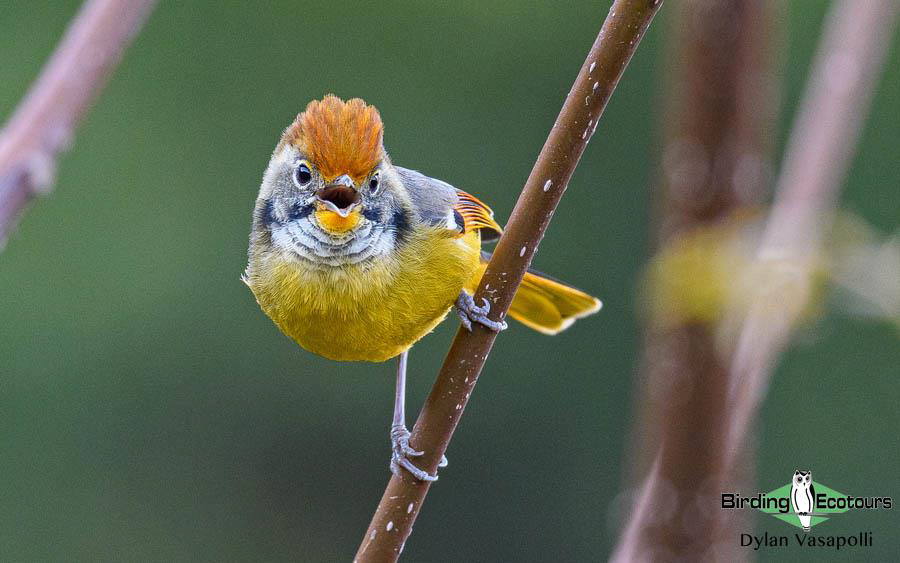
Bar-throated Minla is bird full of colors and attitude.
A few stops on the way added a nesting colony of Nepal House Martins, amongst others, and we arrived in time for a late lunch. Following a short siesta, we headed up the nearby Yotong La Pass for our spell of afternoon birding. The birding was slow to start, but a party of Green-backed Tits brought the area to life, and we soon found ourselves in the middle of an intense bird party. A tiny Green Shrike-babbler hopped into view, followed by a Yellow-bellied Fantail, while some high-pitched calls heralded the arrival of a group of Fire-tailed Myzornis. A mixed flock of noisy Whiskered, Stripe-throated and Rufous-vented Yuhinas were soon joined by an equally rowdy group of Bar-throated Minlas, while some careful watching also gave us our first Red-tailed Minla. It wasn’t close to done, as a vast warbler flock moved in, and we quickly picked up Ashy-throated, Buff-barred, Lemon-rumped, Tickell’s Leaf, Blyth’s Leaf and Whistler’s Warblers. A comical party of Rufous-fronted Bushtits saw the party off. We carried on a little further, coming across a large flock of well over 100 White-throated Laughingthrushes, and also found a perched White-winged Grosbeak. With sunset approaching, we found a few Kalij Pheasants feeding on the edge of the road, and just as it was getting dark, we heard our main target, a Satyr Tragopan calling from way up the hillside. We stuck around until it got dark, with no sighting sadly, and vowed to try again in a few days’ time.
Day 10, 14th April 2023. Birding to Tingtibi
The drive down to Tingtibi from Trongsa is a long, windy road, and combined with regular birding stops, takes the bulk of the day. The higher broad-leafed forests nearer Trongsa were very birdy in the morning. A superb sighting of a Himalayan Cuckoo kicked things off, and was followed soon after by the scarce Plaintive Cuckoo. A pair of the stunning White-browed Shrike-babblers quietly went about their business, before the perhaps even more stunning Black-eared Shrike-babbler took their place. Black-throated Bushtits were seen in places, as were Streak-breasted Scimitar Babblers along with several warblers and yuhinas. A Rusty-fronted Barwing was a good find in an open patch, and here we also picked up both Himalayan and Black-throated Prinias. A roadside stream gave us a fine Spotted Forktail, and Verditer Flycatcher and both Blue-capped and Chestnut-bellied Rock Thrushes were commonly seen. We had several sightings of Mountain Hawk-Eagles flying overhead, and also added a lone Crested Bunting and a pair of very loud Rufous-necked Laughingthrushes to our list.
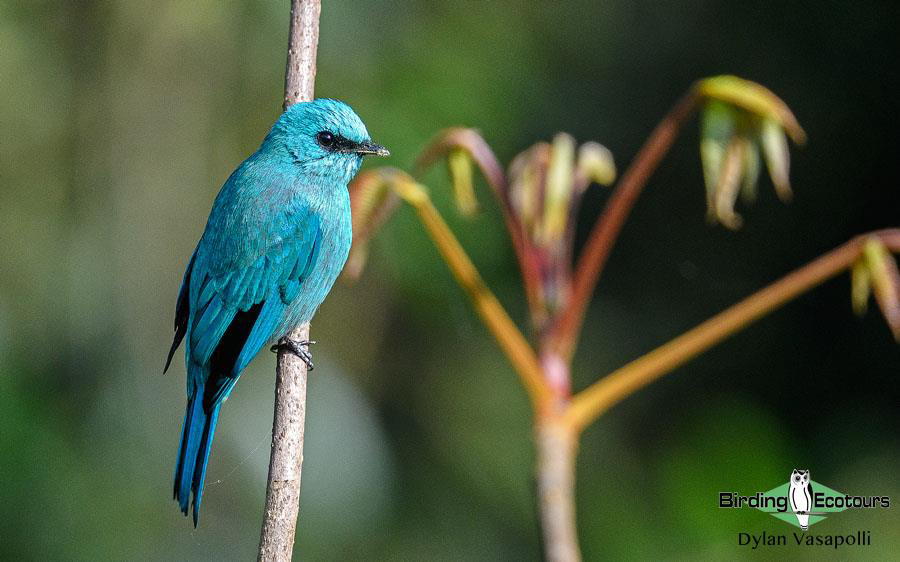
Verditer Flycatchers were commonly seen in Bhutan – but never did we tire of seeing them.
We took a break for lunch at a conveniently placed picnic overlook. Despite the heat kicking in, the birds were still active, and we enjoyed a good walk around the lunch site. We lucked onto a hulking Rufous-necked Hornbill as one flew by, and found a Wedge-tailed Green Pigeon perched quietly in the trees. Both Great and Blue-throated Barbets were common, and we added several new birds like the scarce Grey-headed Parrotbill, Black-winged Cuckooshrike, Grey-chinned Minivet, Ashy Bulbul and Blue-winged Minla. A Streaked Spiderhunter gave us fleeting views and left us wanting a bit more. After lunch, as the altitude started dropping, we did well to find a group of the sought-after Long-tailed Broadbills. A few of their high-pitched calls sent us all piling out of the car, and it took some patience and careful scanning, but we soon picked them up and enjoyed some good views. We also found a few Orange-bellied Leafbirds feeding nearby. As we rounded a corner, a feeding troop of Gee’s Golden Langur brought us to a halt once more, and this also gave us a fine Oriental Hobby perched next to the road. Further along, we were forced to pile out of the car once more when a Sultan Tit flew across the road. We enjoyed some superb views of this bird, and enjoyed White-throated Bulbul, White-browed Scimitar Babbler and Chestnut-bellied Nuthatch in the same vicinity. In the late afternoon, we rolled into Tingtibi, and headed to our rustic, yet charming lodge located on the river out of town. A productive forest patch right before the lodge gave us a pair of scarce Rufous Woodpeckers, along with several showy Blue-throated Barbets as our final birds of this excellent day.
Day 11, 15th April 2023. Birding Tingtibi
Tingtibi is located towards the southern part of Bhutan, and is firmly lowland territory, being only a few hundred meters above sea level, as opposed to a few thousand meters, as with much of the rest of the country. The area is covered in pristine lowland forest, with stands of bamboo thickets, and we headed out this morning with lots of excitement. We didn’t get very far as we spotted a stunning male Rufous-necked Hornbill perched right outside our lodge ground and duly stopped to take it in. Several Common Emerald Doves were feeding on the roadside, and we enjoyed bright Bronzed Drongos along the way. Soon we found ourselves at our first birding area, and set off to explore the mixed forest and bamboo. Large numbers of Scarlet Minivets were flitting around, as were numerous Pin-tailed Green Pigeons. Shy Golden Babblers showed well after some effort, and we added a few Yellow-vented Warblers. The special Rufous-faced Warbler left us all wanting a bit more, while a flock of Pale-billed Parrotbills kept us all on our toes. Blue-throated Blue Flycatcher showed well, as did both Black-throated and Crimson Sunbirds. Just as we broke for breakfast, we picked up on the massive and iconic Great Hornbill flying along the ridgetop.
We carried on working the area after breakfast, but the activity started dying down. We finally got satisfying looks at Streaked Spiderhunter, enjoyed a flock of White-rumped Munias, marveled at how bland the Plain Flowerpecker was and got much better views of the shy White-throated Bulbul. Raptors also started coming out, and we notched up the scarce Rufous-bellied Eagle. Several Ashy Woodswallows were seen flying around, and a vocal Banded Bay Cuckoo gave us excellent views, especially considering this is normally a very shy bird. We broke for lunch, and had our customary short siesta, before resuming with an afternoon walk around the lodge, and the wild surrounds. Activity was a bit slow to start off with, but gradually picked up. A Grey-headed Woodpecker played hide and seek with us, while the comparatively diminutive Grey-capped Pygmy Woodpecker showed very well. A Large Woodshrike swooped in and some raucous calling nearby meant a party of Lesser Necklaced Laughingthrushes were moving through. We latched onto the laughingthrushes, and got some good views, before they melted back into the scrub. A hawking pair of Chestnut-headed Bee-eaters put on a good show, as did several Streaked Spiderhunters. Our last sighting of note went to the enormous Black Giant Squirrel we found moving through some trees, and brought our day to a close.
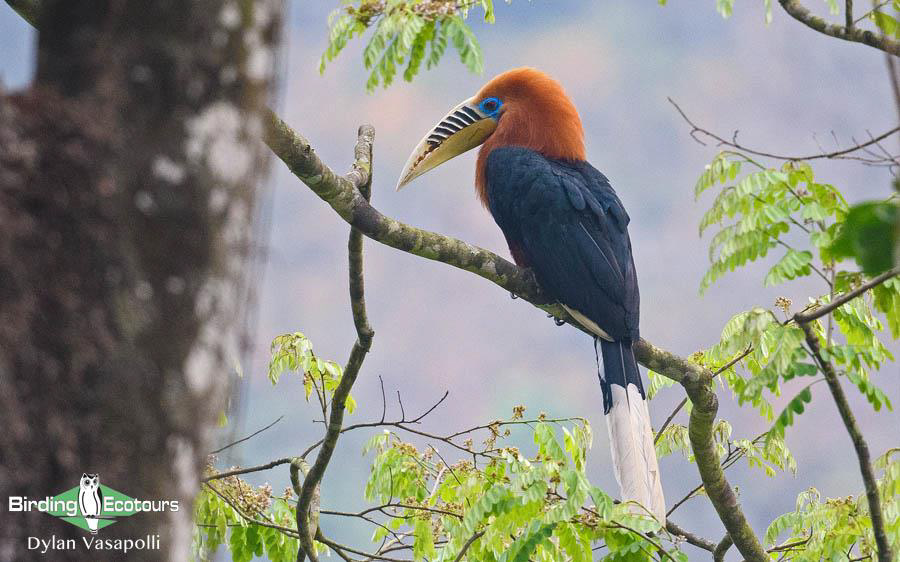
Rufous-necked Hornbill is a desirable special found in the lower altitudes in Bhutan.
Day 12, 16th April 2023. Birding Zhemgang
Our day was dedicated to exploring the higher-altitude forests of Zhemgang, located up above Tingtibi. Here, our main target is the highly sought-after Beautiful Nuthatch. We arrived in good time at the top of the Zhemgang pass, and immediately hopped out of the van and started birding. We caught a bright Red-faced Liocichla napping as it was foraging in the open, but it soon melted back into the scrub. A noisy group of Rusty-fronted Barwings showed well, as did a Greater Yellownape. An explosive call led us to a stunning Asian Emerald Cuckoo, which was perched in the open, while a soft melodic call gave us a Pale Blue Flycatcher. A large feeding flock of the stunning White-naped Yuhinas had a heap of other birds with them which included Chestnut-crowned and Grey-hooded Warblers, Golden and Rufous-capped Babblers, Blue-winged Minla and Orange-bellied Leafbird. A fidgety Little Pied Flycatcher showed well, but try as we might, our nuthatch seemed to be absent. Crimson-breasted Woodpecker showed well, and it took some searching, but we finally got onto some flighty Blue-bearded Bee-eaters. The dramatic Silver-eared Mesia also put on a show for us in a clearing, as did the tiny Fire-breasted Flowerpecker. Breakfast and lunch were enjoyed, and we gradually started making our way back down the mountain to Tingtibi. A fine Great Hornbill showed well en route, while calling Silver-breasted Broadbills frustratingly remained as heard only. We added to our mammal list with an Orange-bellied Himalayan Squirrel. We spent the late afternoon birding around the lodge and nearby river, with the likes of Fulvous-breasted Woodpecker, Scarlet Minivet, Black-crested Bulbul and Chestnut-bellied Nuthatch all showing well.
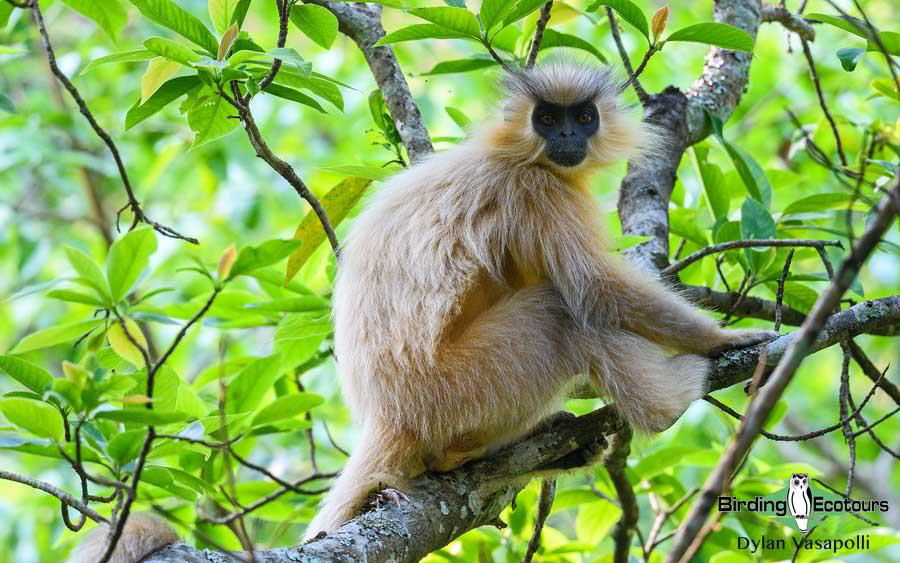
Gee’s Golden Langurs were a highlight of our time around Tingtibi.
Day 13, 17th April 2023. Birding to Trongsa
We would depart our rustic lodge today, and make our way back up to Trongsa, where we were a few days prior. We had a few hours in the morning for some birding, and spent a bit of time exploring the lush forest around our lodge. Here, both Great and Rufous-necked Hornbills put on a fine show for us, and a bright Red-headed Trogon was a magic sighting. We also did well to find a Lesser Yellownape feeding in the trees. We then headed out to the bamboo areas we explored a few days ago, and enjoyed further excellent birding. Somehow, we found a Collared Owlet perched in the open which gave us great views. A large mixed flock of White-breasted and Pale-billed Parrotbills came through, but we again missed the hoped-for White-hooded Babbler. A party of noisy Nepal Fulvettas gave us a fine White-browed Scimitar Babbler and a Yellow-bellied Warbler. Several Common Emerald Doves were seen on the roadside, and we also got lucky with a Red Junglefowl crossing the road. A lovely Mountain Hawk-Eagle flyby capped off our morning.
Before long, we were tackling the slow and windy drive back up to Trongsa. We had multiple birding stops along the way and our first one was for a calling Spotted Elachura. We had obtained only very poor glimpses previously of this shy bird, and spent a while working a very vocal bird calling from the roadside edge. Sadly, we didn’t even get a glimpse this time, but did enjoy repeat views of Lesser Necklaced Laughingthrush and another White-browed Scimitar Babbler. A Crested Serpent Eagle perched nicely next to the road a bit higher up and we added widespread species like Himalayan Bulbul and Siberian Stonechat. A low feeding flock of Blyth’s Swifts gave us excellent views of these aerial masters. A colony of rock bees gave us another Yellow-rumped Honeyguide, a species we were doing well with and had seen numerous times on the tour so far, while a pair of Black Eagles gave us a good flyby as well. The late afternoon birding in the lush forests near Trongsa was very quiet, though a Scaly-breasted Cupwing showed for some.
Day 14, 18th April 2023. Satyr Tragopan birding
We were up pre-dawn and heading up the Yotong La Pass above Trongsa, where we would try for Satyr Tragopan. Numerous calling Hill Partridges greeted us in the early morning, but refused to show. A lovely Crested Goshawk flew over us, and a pair of Darjeerling Woodpeckers drummed from a dead tree. Before long, we heard our tragopan calling, and as it turned out, we heard many different birds calling throughout the morning. The gods weren’t smiling on us sadly, as no matter what we tried or how much patience we showed, we came away empty handed. It was generally a birdy morning and we had many good sightings of species we had seen on the tour already, with tits, warblers, yuhinas, sunbirds and laughingthrushes all obliging. A Dark-sided Flycatcher showed well perched atop a spruce, as did several Olive-backed Pipits, all displaying from the tree tops with spring in the air. As the morning went on, the tragopans stopped calling, and we reluctantly carried on our journey. Fortunately, we weren’t heading far – virtually over the hill to Bumthang. We birded our way down the opposite side of the pass, where we enjoyed a few Large-billed Leaf Warblers along with multiple feeding flocks that included several other warblers, yuhinas, minlas and tits.
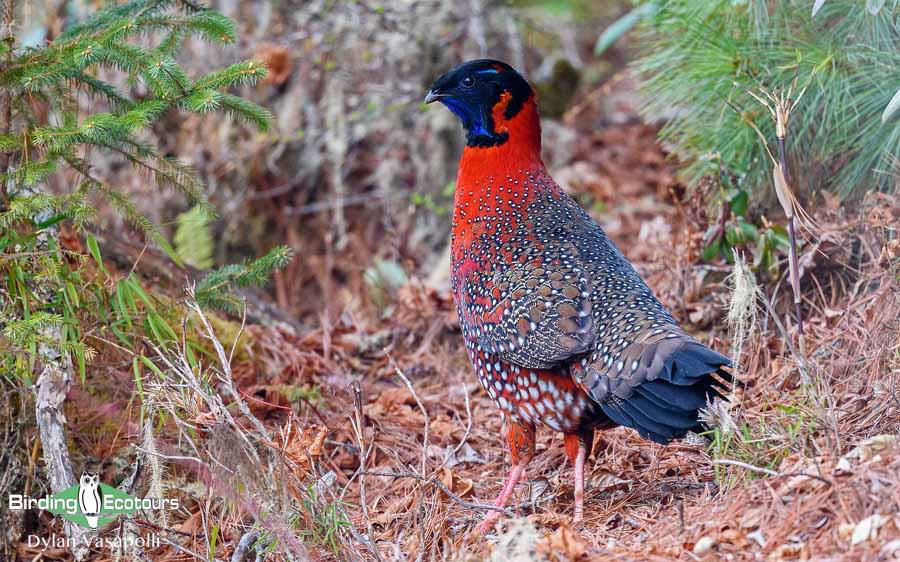
Satyr Tragopan is not only the “top-of-the-list” special for visiting birders to Bhutan, but easily one of the ultimate birds to be found anywhere in the world. We hunted high and low on this tour, and eventually had our day with this mega.
The highly localized Black-rumped Magpie didn’t prove difficult to find once we got into the Bumthang valley. We settled in for a midday break, before heading out for the afternoon. In a last-gasp attempt for the Satyr Tragopan, we headed quite some distance to the Sheytang La Pass. We arrived with a bit of time to bird in the late afternoon, and set about our search, walking around and listening. With time running out before we had to call it a day, we finally heard the mournful call of the bird. Fortunately for us, the call was much closer than we had ever heard it before, and we were quietly confident. We got into position and began scanning the steep forest floor below us, and as if on cue, a bright red shape materialized out of the undergrowth. We all scrambled around for a bit as not everyone could see it, but the bird settled and started calling from a rock. We soaked up magic views of this coveted bird – arguably the most sought-after special for Bhutan. Remarkably, the bird started walking closer and up towards us. We repositioned and had to avoid getting distracted by a close-feeding Hodgson’s Treecreeper, as sure enough, the magnificent Satyr Tragopan hopped onto the road in front of us, quickly crossed and carried on its way. Elated and relieved, we called it a day.
Day 15, 19th April 2023. Alpine birding to Sengor
Our day would involve quite a bit of travel, as we made our way to the Sengor village, located high up on the famous Lingmethang Road. With the Satyr Tragopan monkey off our back, we were able to concentrate our time on finding other birds along the route. We returned over the Sheytang La Pass, where we had our success the previous day, and while we heard a few tragopans calling once more, none were seen. Various bird parties along the route gave us the likes of Coal and Rufous-vented Tits, Lemon-rumped and Whistler’s Warbelrs, White-winged Grosbeak and Red Crossbill, amongst others. We also enjoyed low-flying Himalayan Vultures. Heading onto the Thrumshing La Pass, conditions worsened to a dense cloud cover with bouts of snow and drizzle, but we managed to find a few of the brightly colored Blood Pheasants nonetheless. These birds are of a different race than the earlier birds seen around Chele La Pass. We also did well to finally see a Collared Grosbeak, after having heard them on multiple previous occasions. After some patience, we also finally saw our first Chestnut-headed Tesia, as we watched a pair hopping through an open stream valley in the forest, and the local race of Red Fox was seen crossing the road. We pulled into our very rustic Sengor accommodations, and had a good meal to warm us up.
Our late afternoon was spent birding the small remaining patches of natural vegetation around Sengor. Sadly, major construction on the road here and throughout the rest of the upper Lingmethang Road has resulted in major rockfalls and removed huge swathes of natural habitat. This former birding mecca is now a shadow of what it used to be. The tiny remaining bits of natural habitat were extremely birdy despite the poor conditions. Noisy Yellow-billed Blue Magpies jumped through the trees, while flock after flock passed through. Dainty Yellow-bellied Fantails were common members, along with the usual tits, warblers and yuhinas. Rufous-fronted Bushtits were present, along with several Rufous-winged Fulvettas, and both Red-tailed and Bar-throated Minlas came through in small groups. A fruiting bush attracted a group of Crimson-browed Finches, while both Green-tailed and Mrs. Gould’s Sunbirds vied for attention. With our tesia duck finally broken for good from our sighting earlier in the day, naturally, we enjoyed incredible views of at least two pairs of Chestnut-headed Tesias in a territorial skirmish late in the day, at times almost hopping onto us. A good, hearty and warm meal settled us down for the evening.
Day 16, 20th April 2023. Birding to Yongkhola
Having seen the major habitat destruction, we opted to cut our time in Sengor short, and headed further down the Lingmethang Road to the village of Yongkhola. The windy road took some time to negotiate, and we stopped off for birding wherever suitable patches of natural habitat remained. Many of the same birds seen yesterday afternoon were enjoyed again, though with several Mountain Hawk-Eagle flybys and a very showy Grey-sided Bush Warbler joining the melee. Further down the road, in the mid-elevation Namling region, we found a few suitable patches of remaining habitat, where we spent a while birding. Notably, a few bamboo patches can be accessed and this area offers a different suite of birds to those in the alpine zone higher up. We entered the realm of the cuckoos, with Plaintive, Himalayan and Common Cuckoos all seen, and the closely related Large Hawk-Cuckoo exceedingly common. Our first stand of bamboo gave us the much hoped-for Golden-breasted Fulvetta, and some dedicated birding further along netted us a large party of the dainty Black-throated Parrotbills and the rare Broad-billed Warbler. Golden and Rufous-capped Babblers were welcomed re-finds, as were the likes of Golden-throated Barbet and Rufous-bellied Niltava. While watching a large party of Blue-winged Minlas, typical tit grating calls lead us to a pair of the snazzy Yellow-cheeked Tits, which showed well. We also spent a while looking for Ward’s Trogon, and came close when we finally heard a bird calling off in the distance. With no sighting forthcoming, we vowed to try again. We rolled into the lovely village of Yongkhola, and checked into our excellent accommodations. Unfortunately, major rain curtailed our birding plans for the rest of the day.
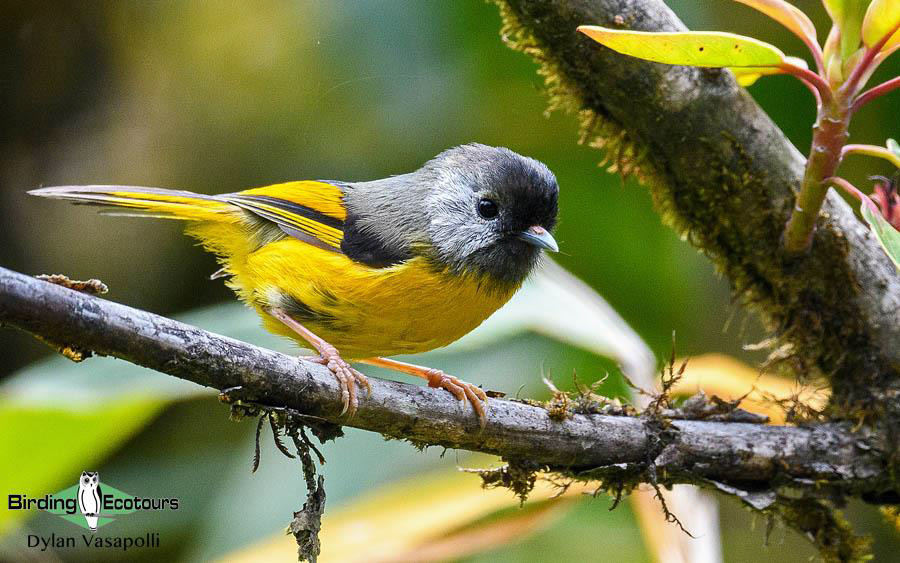
Golden-breasted Fulvetta is a beautiful denizen of bamboo stands within forests. These curious birds put on a fine show for us!
Days 17 – 19, 21st – 23rd April 2023. Birding Yongkhola and the lower Lingmethang Road
We had virtually three full days of birding around Yongkhola, with the final afternoon (Day 19/23rd April) spent transferring the short distance to the nearby town of Mongar. Due to the similar nature of birds seen and sites visited, these days are discussed as one account below.
We concentrated the bulk of our time in the mature, moss-clad, broad-leafed forests that feature in a few places around Yongkhola. Ward’s Trogon, another of Bhutan’s sought-after specials was our first priority. We headed up to the region where we had it calling from on Day 15, and as if right on cue, picked up on not just a single vocal bird, but at least three. The birds were calling intermittently from all around us, and took a great deal of effort to track down. Some careful positioning paid off and we had our views of a male Ward’s Trogon. We ended up spending a while with the bird, watching as it went about its business, totally oblivious to us and giving us excellent close-up views.
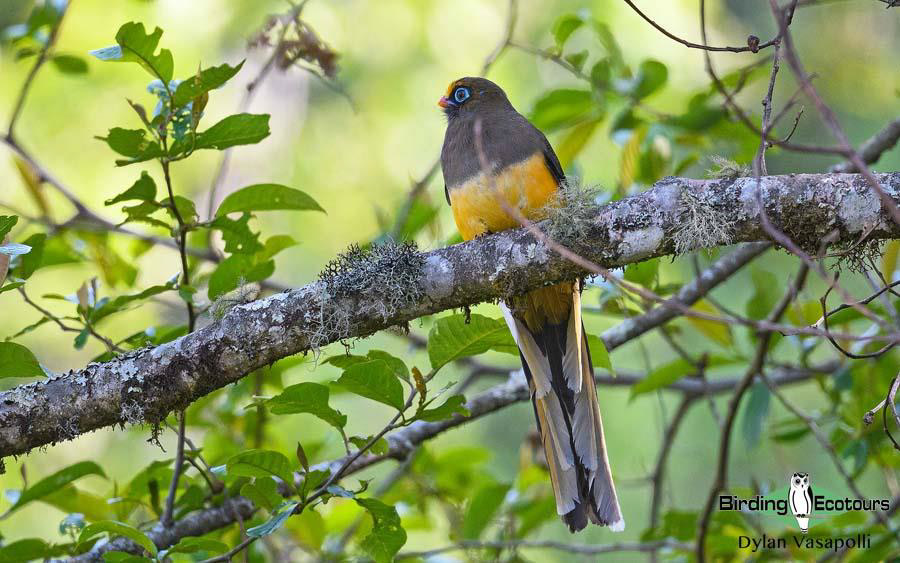
Ward’s Trogon is another of the more sought-after birds occurring within Bhutan.
Beautiful Nuthatch was our second big target for the area, and we shifted focus towards it after our trogon success. Luck was firmly with us, as we enjoyed several excellent sightings of the special Beautiful Nuthatch in various places. Our first sighting took some time and effort, but a short and sharp rain shower brought the forest to life, and with it a stunning sighting of this special bird. As we went about our time searching for these two major targets, we naturally saw many other species. Great and Golden-throated Barbets were exceedingly common and virtually a continuous soundtrack. Woodpeckers were oddly scarce and we only found Crimson-breasted and Rufous-bellied Woodpeckers, along with Lesser Yellownape, while Bay Woodpeckers frustrated us by remaining unseen. Colorful Red-billed Leiothrixs were seen in a fruiting tree, which also attracted others like Lesser Racket-tailed Drongo, Mountain Bulbul, Large Niltava, White-naped Yuhina, Rusty-fronted Barwing and Black-throated Sunbird, amongst many others. We spent a while with the skulkers, and had mixed results. Normally extremely shy birds like Lesser Shortwing and Long-billed Wren-Babbler showed amazingly well to all, and gave us extended close-up views, while others like Scaly and Blue-winged Laughingthrushes put up quite the challenge but showed briefly in the end. Some, like the prized Slender-billed Scimitar Babbler and Spotted Elachura remained heard-only despite our best efforts.
Bamboo patches gave us groups of White-breasted and Pale-billed Parrotbills and several Mountain Tailorbirds, while scrubby thickets delivered up Grey-cheeked Warbler, Rufous-chinned Laughingthrush, Slaty-backed Flycatcher, the stunning Black-crowned (Coral-billed) Scimitar Babbler, Yellow-throated Fulvetta, Silver-eared Mesia, Red-faced Liocichla, Grey-throated Babbler and White-gorgeted Flycatcher. Bright Scarlet Finches dotted some open trees, and parties of the stunning Himalayan Cutia came roving through. We enjoyed several sightings of Collared Owlets, bumping into birds perched in the open, while other favorites included Asian Emerald Cuckoo, Rufous-necked Hornbill, Sultan Tit, Blue Rock Thrush, White-crested Laughingthrush and both Greater Necklaced and Lesser Necklaced Laughingthrushes. Keeping an eye to the sky rewarded us with Himalayan Swiftlets, along with multiple Mountain Hawk-Eagles and Black Eagles. A nighttime search gave us a heard-only Mountain Scops Owl, while mammals were limited to Capped Langurs, which we saw daily. The birding here was generally excellent, and all of our daily lists exceeded 100 species.
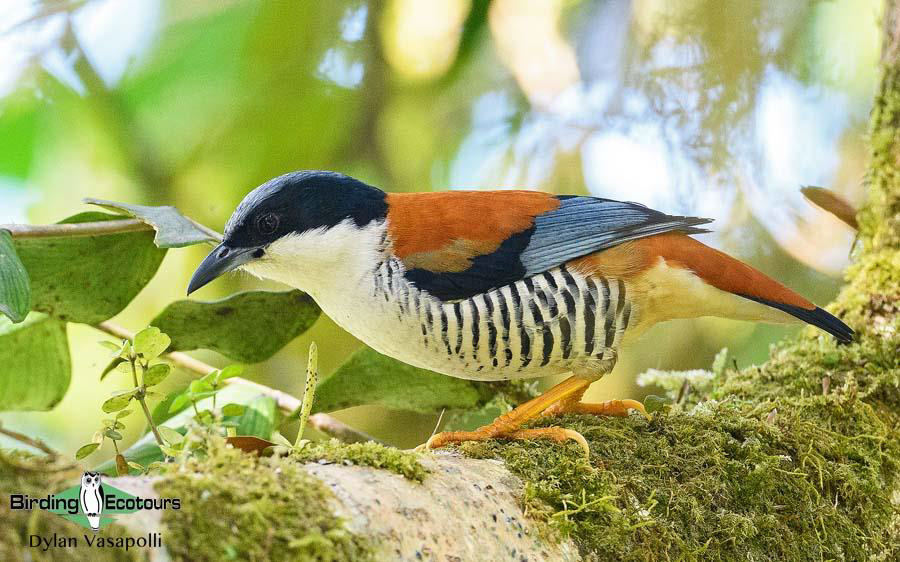
Himalayan Cutia forage amongst the mossy branches.
Day 20, 24th April 2023. Birding Kori La Pass and transfer to Trashigang
We were up and out of Mongar early on, and found ourselves at the top of the Kori La Pass with the sun beginning to warm everything up. It was a cold morning, and activity was limited early on. As we slowly birded along the roadside, we picked up a pair of flashy Greater Yellownapes, which were soon replaced with a Darjeerling Woodpecker. Bird parties started up and brought a bit of life to the area, filled with tits, yuhinas, minlas and warblers we were well familiar with, along with a flock of Yellow-breasted Greenfinches. Several male Ultramarine Flycatchers posed well, as did some Chestnut-crowned Laughingthrushes. We got close to laying eyes on the ever-vocal Hill Partridge, but a poorly timed appearance from some local dogs spooked the partridges and we vowed to fight again. Following a much-needed breakfast and coffee break, we veered off the main road, and onto a forestry track running through the lusher parts of the forest. The birding was immense along here, and we enjoyed several excellent hours of birding. Skulking White-tailed Robins played hide and seek with us, and unfortunately would end up remaining as heard-only despite lots of patience and effort. Grey-bellied Tesia on the other hand, finally showed well, and we enjoyed a few excellent sightings of these tiny birds singing in the open. Parties of the bright Chestnut-crowned and Black-faced Warblers kept us entertained whilst we were trying for a shy White-gorgeted Flycatcher. A small stream produced a fine Spotted Forktail, and the surrounding scrub held a vocal Spotted Elachura, which gave us only glimpses once more. Various flycatchers, laughingthrushes, niltavas, nuthatches and scimitar-babblers all capped off a fine morning of birding! We broke for a traditional lunch in a nearby village, and completed the journey to Trashigang, where we would spend the night. We opted for a bit of sightseeing around the town in the afternoon, before heading to our scenic lodge set in the hills. Grey Nightjars and Collared Scops Owls were vocal around the lodge, but frustratingly both remained unseen.
Day 21, 25th April 2023. Birding Yonphula and Wamrong
On our ‘ordinary’ scheduled tour, this would have been the day we transferred to the lowlands of Samdrup Jonkhar, but the closure of India’s borders meant we could no longer exit Bhutan and end the tour there. Thus, we had set ourselves to overnight along the way, before returning to Trashigang where the tour would end. We spent the entire morning birding along the route, and started the day off well with a party of White-crested Laughingthrushes on the outskirts of our lodge. Starting off in the highlands around the Yonphula airport was productive, and gave us a lovely Northern Goshawk. At the same time, mixed feeding flocks contained a bounty of birds. including favorites like Black-throated Bushtit, Whiskered Yuhina, White-browed Scimitar Babbler, Bhutan Laughingthrush, Bar-throated Minla, Rusty-fronted Barwing and Green-tailed Sunbird, amongst others. Further stops lower down gave us Grey-capped Pygmy Woodpecker, White-throated Fantail, Streak-breasted Scimitar Babbler, Red-billed Leiothrix and Mrs. Gould’s Sunbird.
We eventually arrived in the Wamrong area, where we spent the rest of the morning in superb mixed forest habitat. Great and Golden-throated Barbets called from the treetops once more, while Long-tailed Minivets flitted about and the colorful Black-eared Shrike-babbler entertained us. Vocal Scaly-breasted Cupwings kept us on the hook, and despite being only a few meters away from us, incredibly remained unseen. Some leaf-tossing in the dry undergrowth led us to a pair of Grey-sided Laughingthrushes which put on a good show – a species we had seen somewhat poorly early on in the trip, and a good one to get more satisfactory views of. A particularly dense thicket held a calling Rufous-throated Wren-Babbler, and we were blown away by the incredible views we obtained of this normally ultra-shy bird. A fine party of Himalayan Cutias feeding on the moss-clad trees rounded off a productive morning.
Following a hearty lunch, we ventured off on the windy roads. Unfortunately, major construction was underway, which meant we had to change our plans, and we headed back to Wamrong, where we would spend the night, allowing us access to the excellent forest nearby in the early morning.
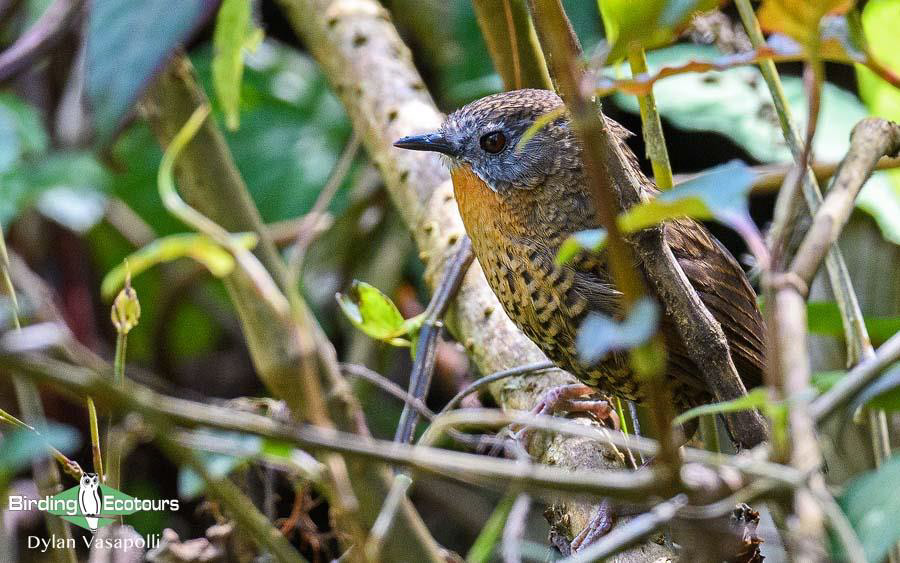
This Rufous-throated Wren-Babbler is a master skulker and rewarded us with incredible views.
Day 22, 26th April 2023. Birding Wamrong and transfer to Trashigang
Dawn arrived and saw us on the excellent Wamrong birding track. We started off well, finding a Pygmy Flycatcher right at the car. Bay Woodpecker was another bird we had been struggling to see on the tour – hearing them on many occasions but without views yet. Our luck was to change this morning, as we finally managed to track down a bird, and enjoyed some great views of this surprisingly large woodpecker with its glorious pale beak! A patch of bamboo gave us the stunning Golden-breasted Fulvetta, while Yellow-cheeked Tits were out in force today. It would also prove to be a good day for tesias, with multiple Chestnut-headed and Grey-bellied Tesias all strutting their stuff and putting on a fine show for all of us. Presumably the same pair of Grey-sided Laughingthrushes we had seen yesterday were still fiddling about in the same area, and we lucked onto a stunning young male Ward’s Trogon whilst having coffee. White-tailed Robin again proved elusive despite our best efforts. Once the day started warming up, the cuckoos came out in full force and we enjoyed picking out a Lesser Cuckoo, from the similar Himalayan and Common Cuckoos – its very different call confirming its identity. Content with another superb morning, and our tally just shy of 100 species, we made the journey to Trashigang, arriving in the mid-afternoon to our comfortable lodge. We spent the remainder of the day sorting our bags and getting ready for our domestic flight back to Paro, the following morning.
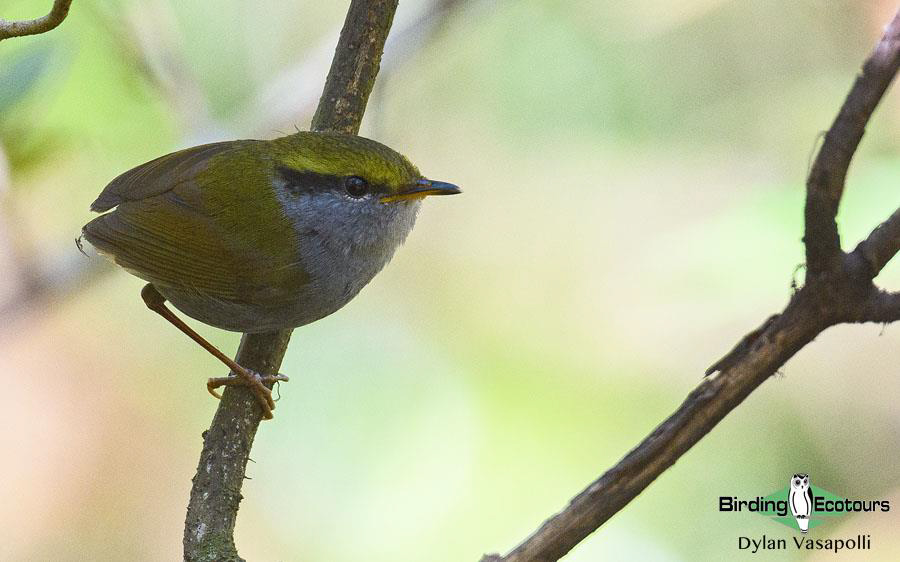
Tesias are normally ultra-shy birds, and this Grey-bellied Tesia showed uncharacteristically well for us – along with its close cousin, Chestnut-headed Tesia.
Day 23, 27th April 2023. Flight to Paro
We had an early morning flight to Paro, from the Yonphula airport. Located high on top of the mountains, on a small ridge, this small regional airport has a somewhat nerve-wracking runway and is one of the more dramatic airports out there. While this largely signaled the end of the birding for the tour, we always kept a beady eye open, and were rewarded with a fine Black-backed Forktail en route, as well as several Greater Yellownapes, Streak-breasted Scimitar Babbler and Oriental Skylark. Our flight was uneventful once we made it through the take-off, and we arrived in Paro in good time. Some final birding in the evening gave us our last White-capped Redstarts, Brown Dippers and, at the last moment, Ibisbill. We settled in for a final dinner, reflecting on all of our many exciting birding moments, and some non-birding memories as well.
Day 24, 28th April 2023. Departure from Paro
Our departure day had arrived and saw us all departing from the stunning Paro airport, bound for New Delhi. Bypassing Mount Everest along the route, we arrived in Delhi, and said our farewells to one another.
I would kindly like to thank Ron and Ruth for making this tour the success it was. This fun bird-filled tour will remain a fond memory for all of us through our lives.
Bird List – Following IOC 12.2
Birds ‘heard only’ are marked with (H) after the common name, all other species were seen.
The following notation after species names is used to show conservation status following the IUCN Red List:
CR = Critically Endangered, EN = Endangered, VU = Vulnerable.
| Common Name | Scientific Name |
| Ducks, Geese, Swans (Anatidae) | |
| Bar-headed Goose | Anser indicus |
| Common Shelduck | Tadorna tadorna |
| Ruddy Shelduck | Tadorna ferruginea |
| Northern Shoveler | Spatula clypeata |
| Gadwall | Mareca strepera |
| Eurasian Wigeon | Mareca penelope |
| Northern Pintail | Anas acuta |
| Red-crested Pochard | Netta rufina |
| Common Pochard – VU | Aythya ferina |
| Tufted Duck | Aythya fuligula |
| Common Merganser | Mergus merganser |
| Pheasants & Allies (Phasianidae) | |
| Hill Partridge (H) | Arborophila torqueola |
| Chestnut-breasted Partridge (H) | Arborophila mandellii |
| Rufous-throated Partridge (H) | Arborophila rufogularis |
| Blood Pheasant | Ithaginis cruentus |
| Satyr Tragopan | Tragopan satyra |
| Himalayan Monal | Lophophorus impejanus |
| Kalij Pheasant | Lophura leucomelanos |
| Red Junglefowl | Gallus gallus |
| Nightjars (Caprimulgidae) | |
| Grey Nightjar (H) | Caprimulgus jotaka |
| Swifts (Apodidae) | |
| Himalayan Swiftlet | Aerodramus brevirostris |
| White-throated Needletail | Hirundapus caudacutus |
| Blyth’s Swift | Apus leuconyx |
| Cuckoos (Cuculidae) | |
| Asian Koel | Eudynamys scolopaceus |
| Asian Emerald Cuckoo | Chrysococcyx maculatus |
| Banded Bay Cuckoo | Cacomantis sonneratii |
| Plaintive Cuckoo | Cacomantis merulinus |
| Large Hawk-Cuckoo | Hierococcyx sparverioides |
| Lesser Cuckoo | Cuculus poliocephalus |
| Himalayan Cuckoo | Cuculus saturatus |
| Common Cuckoo | Cuculus canorus |
| Pigeons, Doves (Columbidae) | |
| Rock Dove | Columba livia |
| Snow Pigeon | Columba leuconota |
| Speckled Wood Pigeon | Columba hodgsonii |
| Oriental Turtle Dove | Streptopelia orientalis |
| Spotted Dove | Spilopelia chinensis |
| Barred Cuckoo-Dove | Macropygia unchall |
| Common Emerald Dove | Chalcophaps indica |
| Pin-tailed Green Pigeon | Treron apicauda |
| Wedge-tailed Green Pigeon | Treron sphenurus |
| Rails, Crakes & Coots (Rallidae) | |
| Eurasian Coot | Fulica atra |
| Black-tailed Crake | Zapornia bicolor |
| Grebes (Podicipedidae) | |
| Great Crested Grebe | Podiceps cristatus |
| Ibisbill (Ibidorhynchidae) | |
| Ibisbill | Ibidorhyncha struthersii |
| Plovers (Charadriidae) | |
| River Lapwing | Vanellus duvaucelii |
| Little Ringed Plover | Charadrius dubius |
| Sandpipers, Snipes (Scolopacidae) | |
| Solitary Snipe | Gallinago solitaria |
| Common Sandpiper | Actitis hypoleucos |
| Green Sandpiper | Tringa ochropus |
| Coursers, Pratincoles (Glareolidae) | |
| Small Pratincole | Glareola lactea |
| Cormorants, Shags (Phalacrocoracidae) | |
| Little Cormorant | Microcarbo niger |
| Great Cormorant | Phalacrocorax carbo |
| Herons, Bitterns (Ardeidae) | |
| White-bellied Heron – CR | Ardea insignis |
| Ospreys (Pandionidae) | |
| Osprey | Pandion haliaetus |
| Kites, Hawks, Eagles (Accipitridae) | |
| Bearded Vulture | Gypaetus barbatus |
| Crested Honey Buzzard | Pernis ptilorhynchus |
| Himalayan Vulture | Gyps himalayensis |
| Crested Serpent Eagle | Spilornis cheela |
| Mountain Hawk-Eagle | Nisaetus nipalensis |
| Rufous-bellied Eagle | Lophotriorchis kienerii |
| Black Eagle | Ictinaetus malaiensis |
| Crested Goshawk | Accipiter trivirgatus |
| Shikra | Accipiter badius |
| Eurasian Sparrowhawk | Accipiter nisus |
| Northern Goshawk | Accipiter gentilis |
| Black Kite | Milvus migrans |
| Pallas’s Fish Eagle – EN | Haliaeetus leucoryphus |
| Himalayan Buzzard | Buteo refectus |
| Owls (Strigidae) | |
| Collared Owlet | Taenioptynx brodiei |
| Mountain Scops Owl (H) | Otus spilocephalus |
| Collared Scops Owl (H) | Otus lettia |
| Trogons (Trogonidae) | |
| Red-headed Trogon | Harpactes erythrocephalus |
| Ward’s Trogon | Harpactes wardi |
| Hoopoes (Upupidae) | |
| Eurasian Hoopoe | Upupa epops |
| Hornbills (Bucerotidae) | |
| Great Hornbill – VU | Buceros bicornis |
| Rufous-necked Hornbill – VU | Aceros nipalensis |
| Kingfishers (Alcedinidae) | |
| White-throated Kingfisher | Halcyon smyrnensis |
| Common Kingfisher | Alcedo atthis |
| Crested Kingfisher | Megaceryle lugubris |
| Bee-eaters (Meropidae) | |
| Blue-bearded Bee-eater | Nyctyornis athertoni |
| Chestnut-headed Bee-eater | Merops leschenaulti |
| Asian Barbets (Megalaimidae) | |
| Great Barbet | Psilopogon virens |
| Golden-throated Barbet | Psilopogon franklinii |
| Blue-throated Barbet | Psilopogon asiaticus |
| Honeyguides (Indicatoridae) | |
| Yellow-rumped Honeyguide | Indicator xanthonotus |
| Woodpeckers (Picidae) | |
| Grey-capped Pygmy Woodpecker | Yungipicus canicapillus |
| Crimson-breasted Woodpecker | Dryobates cathpharius |
| Rufous-bellied Woodpecker | Dendrocopos hyperythrus |
| Fulvous-breasted Woodpecker | Dendrocopos macei |
| Darjeeling Woodpecker | Dendrocopos darjellensis |
| Greater Yellownape | Chrysophlegma flavinucha |
| Lesser Yellownape | Picus chlorolophus |
| Grey-headed Woodpecker | Picus canus |
| Bay Woodpecker | Blythipicus pyrrhotis |
| Rufous Woodpecker | Micropternus brachyurus |
| Caracaras, Falcons (Falconidae) | |
| Common Kestrel | Falco tinnunculus |
| Oriental Hobby | Falco severus |
| Peregrine Falcon | Falco peregrinus |
| Typical Broadbills (Eurylaimidae) | |
| Long-tailed Broadbill | Psarisomus dalhousiae |
| Silver-breasted Broadbill (H) | Serilophus lunatus |
| Vangas & Allies (Vangidae) | |
| Large Woodshrike | Tephrodornis virgatus |
| Woodswallows, Butcherbirds & Allies (Artamidae) | |
| Ashy Woodswallow | Artamus fuscus |
| Cuckooshrikes (Campephagidae) | |
| Grey-chinned Minivet | Pericrocotus solaris |
| Short-billed Minivet | Pericrocotus brevirostris |
| Long-tailed Minivet | Pericrocotus ethologus |
| Scarlet Minivet | Pericrocotus speciosus |
| Black-winged Cuckooshrike | Lalage melaschistos |
| Shrikes (Laniidae) | |
| Brown Shrike | Lanius cristatus |
| Long-tailed Shrike | Lanius schach |
| Grey-backed Shrike | Lanius tephronotus |
| Vireos, Greenlets, Shrike-babblers (Vireonidae) | |
| Green Shrike-babbler | Pteruthius xanthochlorus |
| Black-eared Shrike-babbler | Pteruthius melanotis |
| Blyth’s Shrike-babbler | Pteruthius aeralatus |
| White-bellied Erpornis (H) | Erpornis zantholeuca |
| Figbirds, Old World Orioles, Piopios (Oriolidae) | |
| Maroon Oriole | Oriolus traillii |
| Drongos (Dicruridae) | |
| Bronzed Drongo | Dicrurus aeneus |
| Lesser Racket-tailed Drongo | Dicrurus remifer |
| Hair-crested Drongo | Dicrurus hottentottus |
| Ashy Drongo | Dicrurus leucophaeus |
| Fantails (Rhipiduridae) | |
| White-throated Fantail | Rhipidura albicollis |
| Crows, Jays (Corvidae) | |
| Eurasian Jay | Garrulus glandarius |
| Yellow-billed Blue Magpie | Urocissa flavirostris |
| Common Green Magpie | Cissa chinensis |
| Grey Treepie | Dendrocitta formosae |
| Black-rumped Magpie | Pica bottanensis |
| Spotted Nutcracker | Nucifraga caryocatactes |
| Red-billed Chough | Pyrrhocorax pyrrhocorax |
| House Crow | Corvus splendens |
| Large-billed Crow | Corvus macrorhynchos |
| Fairy Flycatchers (Stenostiridae) | |
| Yellow-bellied Fantail | Chelidorhynx hypoxanthus |
| Grey-headed Canary-flycatcher | Culicicapa ceylonensis |
| Tits, Chickadees (Paridae) | |
| Yellow-browed Tit | Sylviparus modestus |
| Sultan Tit | Melanochlora sultanea |
| Rufous-vented Tit | Periparus rubidiventris |
| Coal Tit | Periparus ater |
| Grey-crested Tit | Lophophanes dichrous |
| Green-backed Tit | Parus monticolus |
| Yellow-cheeked Tit | Machlolophus spilonotus |
| Larks (Alaudidae) | |
| Oriental Skylark | Alauda gulgula |
| Bulbuls (Pycnonotidae) | |
| White-throated Bulbul | Alophoixus flaveolus |
| Striated Bulbul | Alcurus striatus |
| Ashy Bulbul | Hemixos flavala |
| Mountain Bulbul | Ixos mcclellandii |
| Black Bulbul | Hypsipetes leucocephalus |
| Red-vented Bulbul | Pycnonotus cafer |
| Himalayan Bulbul | Pycnonotus leucogenys |
| Swallows, Martins (Hirundinidae) | |
| Barn Swallow | Hirundo rustica |
| Nepal House Martin | Delichon nipalense |
| Asian House Martin | Delichon dasypus |
| Cupwings (Pnoepygidae) | |
| Scaly-breasted Cupwing | Pnoepyga albiventer |
| Cettia Bush Warblers & Allies (Cettiidae) | |
| Yellow-bellied Warbler | Abroscopus superciliaris |
| Black-faced Warbler | Abroscopus schisticeps |
| Mountain Tailorbird | Phyllergates cucullatus |
| Broad-billed Warbler | Tickellia hodgsoni |
| Brown-flanked Bush Warbler | Horornis fortipes |
| Grey-bellied Tesia | Tesia cyaniventer |
| Slaty-bellied Tesia (H) | Tesia olivea |
| Grey-sided Bush Warbler | Cettia brunnifrons |
| Chestnut-headed Tesia | Cettia castaneocoronata |
| Bushtits (Aegithalidae) | |
| Black-throated Bushtit | Aegithalos concinnus |
| Rufous-fronted Bushtit | Aegithalos iouschistos |
| Leaf Warblers (Phylloscopidae) | |
| Buff-barred Warbler | Phylloscopus pulcher |
| Ashy-throated Warbler | Phylloscopus maculipennis |
| Hume’s Leaf Warbler | Phylloscopus humei |
| Yellow-browed Warbler | Phylloscopus inornatus |
| Lemon-rumped Warbler | Phylloscopus chloronotus |
| Tickell’s Leaf Warbler | Phylloscopus affinis |
| Grey-cheeked Warbler | Phylloscopus poliogenys |
| Green-crowned Warbler | Phylloscopus burkii |
| Whistler’s Warbler | Phylloscopus whistleri |
| Greenish Warbler | Phylloscopus trochiloides |
| Large-billed Leaf Warbler | Phylloscopus magnirostris |
| Chestnut-crowned Warbler | Phylloscopus castaniceps |
| Yellow-vented Warbler | Phylloscopus cantator |
| Blyth’s Leaf Warbler | Phylloscopus reguloides |
| Grey-hooded Warbler | Phylloscopus xanthoschistos |
| Cisticolas & Allies (Cisticolidae) | |
| Himalayan Prinia | Prinia crinigera |
| Black-throated Prinia | Prinia atrogularis |
| Rufescent Prinia | Prinia rufescens |
| Common Tailorbird | Orthotomus sutorius |
| Parrotbills & Allies (Paradoxornithidae) | |
| Fire-tailed Myzornis | Myzornis pyrrhoura |
| Golden-breasted Fulvetta | Lioparus chrysotis |
| White-browed Fulvetta | Fulvetta vinipectus |
| Great Parrotbill | Conostoma aemodium |
| Grey-headed Parrotbill | Psittiparus gularis |
| White-breasted Parrotbill | Psittiparus ruficeps |
| Black-throated Parrotbill | Suthora nipalensis |
| Pale-billed Parrotbill | Chleuasicus atrosuperciliaris |
| White-eyes (Zosteropidae) | |
| Striated Yuhina | Staphida castaniceps |
| Black-chinned Yuhina | Yuhina nigrimenta |
| Whiskered Yuhina | Yuhina flavicollis |
| White-naped Yuhina | Yuhina bakeri |
| Stripe-throated Yuhina | Yuhina gularis |
| Rufous-vented Yuhina | Yuhina occipitalis |
| Indian White-eye | Zosterops palpebrosus |
| Babblers, Scimitar Babblers (Timaliidae) | |
| Golden Babbler | Cyanoderma chrysaeum |
| Rufous-capped Babbler | Cyanoderma ruficeps |
| Rufous-throated Wren-Babbler | Spelaeornis caudatus |
| Coral-billed Scimitar Babbler | Pomatorhinus ferruginosus |
| Slender-billed Scimitar Babbler (H) | Pomatorhinus superciliaris |
| Streak-breasted Scimitar Babbler | Pomatorhinus ruficollis |
| White-browed Scimitar Babbler | Pomatorhinus schisticeps |
| Rusty-cheeked Scimitar Babbler | Erythrogenys erythrogenys |
| Grey-throated Babbler | Stachyris nigriceps |
| Ground Babblers (Pellorneidae) | |
| Yellow-throated Fulvetta | Schoeniparus cinereus |
| Rufous-winged Fulvetta | Schoeniparus castaneceps |
| Long-billed Wren-Babbler | Napothera malacoptila |
| Alcippe Fulvettas (Alcippeidae) | |
| Nepal Fulvetta | Alcippe nipalensis |
| Laughingthrushes & Allies (Leiothrichidae) | |
| Striated Laughingthrush | Grammatoptila striata |
| Himalayan Cutia | Cutia nipalensis |
| Scaly Laughingthrush | Trochalopteron subunicolor |
| Blue-winged Laughingthrush | Trochalopteron squamatum |
| Bhutan Laughingthrush | Trochalopteron imbricatum |
| Black-faced Laughingthrush | Trochalopteron affine |
| Chestnut-crowned Laughingthrush | Trochalopteron erythrocephalum |
| Rufous Sibia | Heterophasia capistrata |
| Rufous-backed Sibia | Leioptila annectens |
| Blue-winged Minla | Actinodura cyanouroptera |
| Bar-throated Minla | Actinodura strigula |
| Rusty-fronted Barwing | Actinodura egertoni |
| Red-billed Leiothrix | Leiothrix lutea |
| Silver-eared Mesia – EN | Leiothrix argentauris |
| Red-tailed Minla | Minla ignotincta |
| Red-faced Liocichla | Liocichla phoenicea |
| Lesser Necklaced Laughingthrush | Garrulax monileger |
| White-crested Laughingthrush | Garrulax leucolophus |
| Rufous-chinned Laughingthrush | Ianthocincla rufogularis |
| Spotted Laughingthrush | Ianthocincla ocellata |
| Rufous-necked Laughingthrush | Pterorhinus ruficollis |
| Greater Necklaced Laughingthrush | Pterorhinus pectoralis |
| White-throated Laughingthrush | Pterorhinus albogularis |
| Grey-sided Laughingthrush | Pterorhinus caerulatus |
| Goldcrests, Kinglets (Regulidae) | |
| Goldcrest | Regulus regulus |
| Elachura (Elachuridae) | |
| Spotted Elachura (H) | Elachura formosa |
| Nuthatches (Sittidae) | |
| Beautiful Nuthatch – VU | Sitta formosa |
| White-tailed Nuthatch | Sitta himalayensis |
| Chestnut-bellied Nuthatch | Sitta cinnamoventris |
| Treecreepers (Certhiidae) | |
| Hodgson’s Treecreeper | Certhia hodgsoni |
| Sikkim Treecreeper | Certhia discolor |
| Starlings, Rhabdornises (Sturnidae) | |
| Great Myna | Acridotheres grandis |
| Common Myna | Acridotheres tristis |
| Chestnut-tailed Starling | Sturnia malabarica |
| Thrushes (Turdidae) | |
| Alpine Thrush | Zoothera mollissima |
| Grey-winged Blackbird | Turdus boulboul |
| Black-throated Thrush | Turdus atrogularis |
| Red-throated Thrush | Turdus ruficollis |
| Chestnut Thrush | Turdus rubrocanus |
| White-collared Blackbird | Turdus albocinctus |
| Chats, Old World Flycatchers (Muscicapidae) | |
| Oriental Magpie-Robin | Copsychus saularis |
| Dark-sided Flycatcher | Muscicapa sibirica |
| Ferruginous Flycatcher | Muscicapa ferruginea |
| White-gorgeted Flycatcher (H) | Anthipes monileger |
| Pale Blue Flycatcher | Cyornis unicolor |
| Blue-throated Blue Flycatcher | Cyornis rubeculoides |
| Rufous-bellied Niltava | Niltava sundara |
| Large Niltava | Niltava grandis |
| Small Niltava | Niltava macgrigoriae |
| Verditer Flycatcher | Eumyias thalassinus |
| Lesser Shortwing | Brachypteryx leucophris |
| White-tailed Robin (H) | Myiomela leucura |
| Himalayan Bluetail | Tarsiger rufilatus |
| Black-backed Forktail | Enicurus immaculatus |
| Slaty-backed Forktail | Enicurus schistaceus |
| Spotted Forktail | Enicurus maculatus |
| Blue Whistling Thrush | Myophonus caeruleus |
| Slaty-backed Flycatcher | Ficedula erithacus |
| Pygmy Flycatcher | Ficedula hodgsoni |
| Rufous-gorgeted Flycatcher | Ficedula strophiata |
| Ultramarine Flycatcher | Ficedula superciliaris |
| Little Pied Flycatcher | Ficedula westermanni |
| Slaty-blue Flycatcher | Ficedula tricolor |
| Taiga Flycatcher | Ficedula albicilla |
| Hodgson’s Redstart | Phoenicurus hodgsoni |
| Blue-fronted Redstart | Phoenicurus frontalis |
| Plumbeous Water Redstart | Phoenicurus fuliginosus |
| White-capped Redstart | Phoenicurus leucocephalus |
| Blue Rock Thrush | Monticola solitarius |
| Chestnut-bellied Rock Thrush | Monticola rufiventris |
| Blue-capped Rock Thrush | Monticola cinclorhyncha |
| Siberian Stonechat | Saxicola maurus |
| Grey Bush Chat | Saxicola ferreus |
| Dippers (Cinclidae) | |
| Brown Dipper | Cinclus pallasii |
| Leafbirds (Chloropseidae) | |
| Orange-bellied Leafbird | Chloropsis hardwickii |
| Flowerpeckers (Dicaeidae) | |
| Plain Flowerpecker | Dicaeum minullum |
| Fire-breasted Flowerpecker | Dicaeum ignipectus |
| Sunbirds (Nectariniidae) | |
| Mrs. Gould’s Sunbird | Aethopyga gouldiae |
| Green-tailed Sunbird | Aethopyga nipalensis |
| Black-throated Sunbird | Aethopyga saturata |
| Crimson Sunbird | Aethopyga siparaja |
| Fire-tailed Sunbird | Aethopyga ignicauda |
| Streaked Spiderhunter | Arachnothera magna |
| Old World Sparrows, Snowfinches (Passeridae) | |
| Russet Sparrow | Passer cinnamomeus |
| Eurasian Tree Sparrow | Passer montanus |
| Waxbills, Munias & Allies (Estrildidae) | |
| White-rumped Munia | Lonchura striata |
| Accentors (Prunellidae) | |
| Alpine Accentor | Prunella collaris |
| Altai Accentor | Prunella himalayana |
| Rufous-breasted Accentor | Prunella strophiata |
| Wagtails, Pipits (Motacillidae) | |
| Citrine Wagtail | Motacilla citreola |
| Grey Wagtail | Motacilla cinerea |
| White Wagtail | Motacilla alba |
| White-browed Wagtail | Motacilla maderaspatensis |
| Olive-backed Pipit | Anthus hodgsoni |
| Rosy Pipit | Anthus roseatus |
| Finches, Euphonias (Fringillidae) | |
| Collared Grosbeak | Mycerobas affinis |
| White-winged Grosbeak | Mycerobas carnipes |
| Red-headed Bullfinch | Pyrrhula erythrocephala |
| Plain Mountain Finch | Leucosticte nemoricola |
| Common Rosefinch | Carpodacus erythrinus |
| Scarlet Finch | Carpodacus sipahi |
| Crimson-browed Finch | Carpodacus subhimachalus |
| Yellow-breasted Greenfinch | Chloris spinoides |
| Red Crossbill | Loxia curvirostra |
| Buntings (Emberizidae) | |
| Crested Bunting | Emberiza lathami |
| Little Bunting | Emberiza pusilla |
| Species seen: | 301 |
| Species heard: | 13 |
| Total recorded: | 314 |
Mammal List
Mammals ‘heard only’ are marked with (H) after the common name, all other species were seen.
The following notation after species names is used to show conservation status following the IUCN Red List:
EN = Endangered, VU = Vulnerable.
| Common Name | Scientific Name |
| Pikas (Ochotonidae) | |
| Large-eared Pika | Ochotona macrotis |
| Moupin Pika | Ochotona thibetana |
| Squirrels and Relatives (Sciuridae) | |
| Black Giant Squirrel | Ratufa bicolor |
| Himalayan Striped Squirrel | Tamiops mcclellandii |
| Orange-bellied Himalayan Squirrel | Dremomys lokriah |
| Old World Monkeys (Cercopithecidae) | |
| Assam Macaque | Macaca assamensis |
| Rhesus Monkey | Macaca mulatta |
| Gee’s Golden Langur – EN | Trachypithecus geei |
| Capped Langur – VU | Trachypithecus pileatus |
| Canids (Canidae) | |
| Red Fox | Vulpes vulpes |
| Mustelids (Mustelidae) | |
| Yellow-throated Marten | Martes flavigula |
| Deer, Elk, Mooses (Cervidae) | |
| Northern Red Muntjac | Muntiacus vaginalis |
| Species seen: | 12 |
| Total recorded: | 14 |
This is a sample trip report. Please email us ([email protected]) for more trip reports from this destination.
